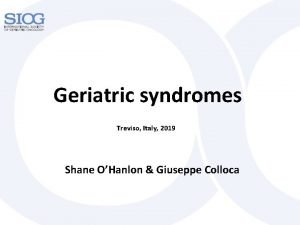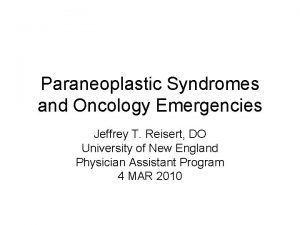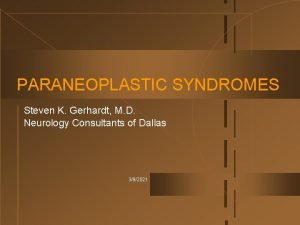Chapter 27 Paraneoplastic Syndromes Involving the Nervous System





- Slides: 5

Chapter 27 Paraneoplastic Syndromes Involving the Nervous System Jerome B. Posner Copyright © 2014 Elsevier Inc. All rights reserved. 1

Figure 27 -1 Axial fluid-attenuated inversion recovery (FLAIR) magnetic resonance imaging (MRI) of a patient with paraneoplastic limbic encephalopathy. There is marked hyperintensity in the medial temporal lobes bilaterally. In addition, there is slight dilatation of the temporal horns, suggesting atrophy. Copyright © 2014 Elsevier Inc. All rights reserved. 2

Figure 27 -2 A, Normal sagittal MRI of the brain. B, T 1 contrast-enhanced sagittal MRI of the brain in a patient with paraneoplastic cerebellar degeneration. The cerebellum is atrophic, but the rest of the brain is normal. Copyright © 2014 Elsevier Inc. All rights reserved. 3

Figure 27 -3 Paraneoplastic cerebellar degeneration. A, Section of cerebellum of a patient who died of cancer without cerebellar symptoms. Multiple Purkinje cells are identified between the molecular (top) and granule cell (bottom) layers, both of which are normal. (Hematoxylin–eosin× 25. ) B, Section of cerebellum from a patient with autoantibody-positive paraneoplastic cerebellar degeneration. The molecular and granular cell layers are relatively normal, but Purkinje cells are absent, and there is a slight increase in Bergmann astroglia along with some inflammatory cells in the leptomeninges. (Hematoxylin–eosin× 25. ) Copyright © 2014 Elsevier Inc. All rights reserved. 4

Figure 27 -4 Paraneoplastic sensory neuronopathy. A, Dorsal root ganglion obtained at autopsy from a patient without neurologic disease. B, Dorsal root ganglion obtained from a patient with paraneoplastic sensory neuronopathy and anti-Hu antibodies. Note that there are virtually no normal dorsal root ganglion neurons in the entire section. A few scattered inflammatory infiltrates are present. (Hematoxylin–eosin× 40. ) C, The dorsal root ganglion of another patient with anti-Hu-related subacute sensory neuronopathy. Degenerating neurons can be seen surrounded by inflammatory cells. (Hematoxylin–eosin× 40. ) Copyright © 2014 Elsevier Inc. All rights reserved. 5








